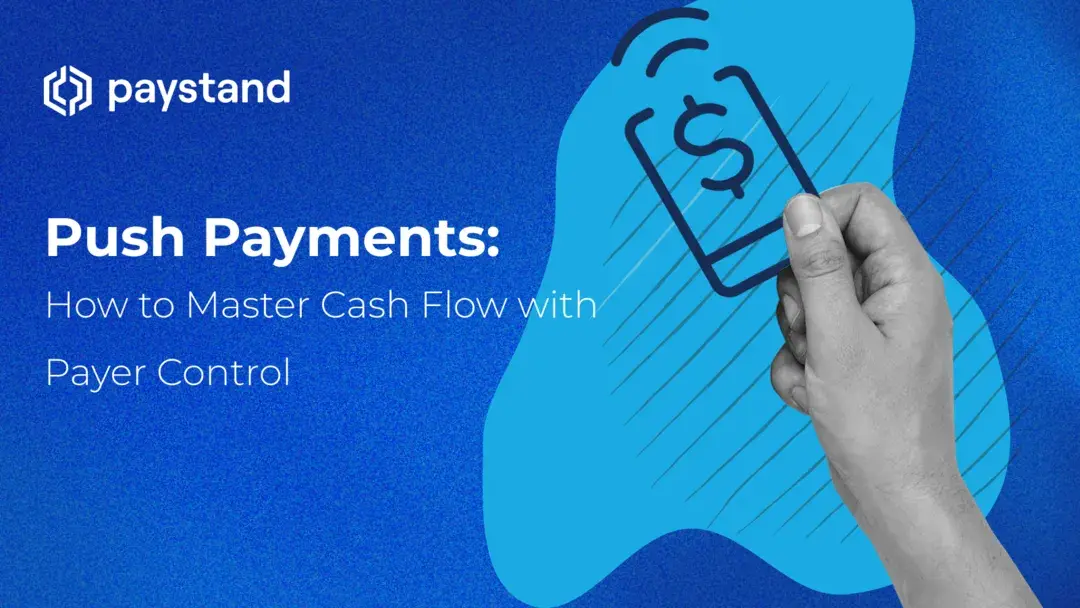Push Payments: How to Master Cash Flow with Payer Control

Table of Contents
- What is a push payment?
- Push vs. pull payments: the core differences
- Why push payments matter for finance teams
- Optimizing push payments with communication strategies
- The rise of automated push payments
- Embedded payments and push payment technology
- Preventing fraud in authorized push payments (APP)
- Empowering push payments with Paystand
Key Takeaways
- Push payments empower payers to control cash flow, enhancing security, timing, and efficiency. They improve cash flow management, lower transaction costs, and minimize disputes, making them ideal for finance teams.
- Effective communication strategies, such as timely payment reminders and dunning letters, are essential for optimizing push payment success.
- Automation and embedded payments streamline push payment processes, enabling faster payments, error reduction, and enhanced financial visibility.
- Authorized Push Payment (APP) fraud can be mitigated with multi-factor authentication, payee verification, and secure payment platforms.
Picture your finance team orchestrating cash flow with precision—timing payments exactly when needed while safeguarding security and improving vendor relationships. This is the transformative potential of push payments in B2B finance.
In this guide, we’ll break down how they work and explore how they enhance financial processes. You’ll also discover how automation and embedded payments streamline the experience, empowering finance teams to reduce costs, boost cash flow control, and prevent disputes. Ready to elevate your payment strategy? Let’s dive in.
What Is a Push Payment?
A push payment is a transaction in which the payer (a customer or business) actively initiates and authorizes funds transfer to the recipient (a vendor or service provider). Unlike pull payments, where the recipient requests funds from the payer’s account, these require the payer to control the transaction entirely, ensuring that money moves only when authorized.
Examples include:
- Bank transfers where a sender authorizes funds to be sent directly to a payee’s account.
- Wire transfers initiated by individuals or businesses.
- Cryptocurrency transactions where users send funds from a digital wallet.
Push payments are particularly valuable in business-to-business (B2B) settings and real-time payment environments, providing both parties with clarity and confidence in the transaction’s timing and status.
Control and Timing
A core advantage of payer-initiated transactions is control over payment timing and amount. This is especially important in accounts payable, where managing payment schedules impacts cash flow.
In contrast, pull payments, like automated debit agreements, give the recipient more control. However, this can introduce complications if payment timing or amounts aren’t managed carefully. Disputed pull payments, for instance, can result in chargebacks—a scenario that push payments largely avoid.
Security
With payer authorization at their core, these transactions offer superior security by eliminating unauthorized initiations. Pull payment systems—such as direct debit—require pre-authorized agreements, which, if compromised, could lead to unauthorized withdrawals.
Push vs. Pull Payments: The Core Differences
Both terms describe how money flows between accounts and who initiates the transaction. Let’s examine how these two models differ.
| Push Payment | Pull Payment |
|---|---|
| Initiated and authorized by the payer. | Initiated by the payee (recipient). |
| Funds are transferred only after the payer sends them. | Payee pulls funds from the payer’s account, often with prior authorization. |
| Examples: bank transfers, wire transfers, ACH credit transfers. | Examples: automatic bill payments, credit card transactions, subscriptions. |
| Reduces risk of unauthorized transactions. | Relies on trust or agreements for pulling payments. |
Why Push Payments Matter for Finance Teams
Push payments offer several advantages, making them ideal for finance and accounting professionals who want to optimize cash flow, reduce disputes, and lower transaction costs.
- Cash flow control: Since payers control when payments are sent, they reduce surprises in cash flow management. Businesses can plan disbursements more accurately, preventing liquidity issues.
- Fewer chargebacks: Chargebacks, common in pull-based credit card payments, are minimized with push payments because they require explicit action from the payer. Once funds are pushed, the transaction is typically final and irreversible.
- Lower fees: Many push payment methods, particularly ACH transfers or real-time payment systems, bypass credit card networks, leading to reduced processing fees. This cost-efficiency benefits both businesses and consumers.
Optimizing Push Payments with Communication Strategies
Even though push payments are efficient, proactive communication is critical for timely B2B payments. Incorporating payment reminders and follow-up processes helps create a seamless customer experience and strengthens cash flow management. Here’s how Paystand’s payment communication strategies can enhance push payment success.
Using Payment Reminders Effectively
Professionally crafted reminders can encourage prompt payments. Combining them with reminders allows businesses to maintain control without being perceived as aggressive or overly persistent.
For example:
- Initial reminders: Send a polite reminder a few days before the payment due date, including details about the payment method and push payment instructions.
- Follow-ups: After the due date passes, a more urgent reminder can be sent to reference prior communications and direct payment links can be included to streamline the process.
Using automated payment reminder tools helps reduce manual follow-up efforts while providing customers with a clear path to action.
The Role of Dunning Letters
For situations where reminders aren’t sufficient, dunning letters—formal notices of overdue payments—come into play. Our dunning letter guide outlines how structured communications can escalate payment requests while maintaining professionalism. Combining push payment capabilities with automated dunning letters can reduce delinquency rates and improve recovery time.
The Rise of Automated Push Payments
Automation is transforming how businesses handle push payments, making them faster and more reliable. Automated push payment systems integrate directly into accounting platforms, enabling businesses to:
- Schedule recurring payments without manual intervention.
- Send real-time payment notifications to vendors and customers.
- Automatically reconcile payments once they are processed.
Automation eliminates errors and reduces administrative burdens, freeing finance teams to focus on strategic activities.
Embedded Payments and Push Payment Technology
Push payments are often integrated into embedded payment systems, where payment functionality is built directly into business software or customer portals. This eliminates the need to leave an invoice platform or payment request system to complete a transaction. For example, an embedded payment button in an e-invoice allows customers to push funds immediately without additional steps.
Benefits of embedded payments:
- Seamless user experience: Customers can pay directly via email or invoice.
- Faster payment cycles: Reduced friction leads to quicker payment processing.
- Enhanced data integration: Payments link directly to accounting records, improving financial visibility.
Preventing Fraud in Authorized Push Payments (APP)
An Authorized Push Payment (APP) is a transaction where the payer willingly initiates and approves the payment. While APP fraud—where scammers deceive payers into transferring money to fraudulent accounts—poses a risk, businesses can mitigate it by:
- Verifying Payee Details: Confirming the legitimacy of payee information before sending funds.
- Implementing Multi-Factor Authentication (MFA): Adding layers of identity verification.
- Using Secure Payment Platforms: Leveraging encrypted, compliant systems reduces exposure to fraud.
APP fraud prevention is critical as real-time and international push payment systems grow in adoption.
Empowering Payments with Paystand
Paystand revolutionizes digital payments by offering a modern payment network that eliminates transaction fees and improves cash flow. With automated payment reminders, robust dunning letter capabilities, and seamless embedded payment solutions, Paystand enhances the efficiency and security of push payment strategies. Integrating automation into your accounts receivable processes will reduce manual follow-ups, minimize chargebacks, and streamline cash management.
Take control of your payment operations with technology designed to work for you. Experience the Paystand difference—where faster, smarter payments drive better business outcomes. Book a demo today to explore how automation can transform your financial results.





